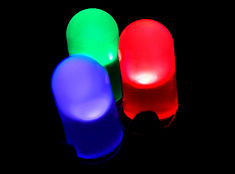A light-emitting diode (LED) is a semiconductor light source.[3] LEDs are used as indicator lamps in many devices and are increasingly used for other lighting. Introduced as a practical electronic component in 1962,[4] early LEDs emitted low-intensity red light, but modern versions are available across the visible, ultraviolet, and infrared wavelengths, with very high brightness.
When a light-emitting diode is forward-biased (switched on), electrons are able to recombine with electron holes within the device, releasing energy in the form of photons. This effect is called electroluminescence and the color of the light (corresponding to the energy of the photon) is determined by the energy gap of the semiconductor. LEDs are often small in area (less than 1 mm2), and integrated optical components may be used to shape its radiation pattern.[5] LEDs present many advantages over incandescent light sources including lower energy consumption, longer lifetime, improved robustness, smaller size, and faster switching. LEDs powerful enough for room lighting are relatively expensive and require more precise current and heat management than compactfluorescent lamp sources of comparable output.
Light-emitting diodes are used in applications as diverse as aviation lighting, automotive lighting, advertising, general lighting, andtraffic signals. LEDs have allowed new text, video displays, and sensors to be developed, while their high switching rates are also useful in advanced communications technology. Infrared LEDs are also used in the remote control units of many commercial products including televisions, DVD players, and other domestic appliances.
"LED" redirects here. For other uses, see LED (disambiguation).
| Light-emitting diode | |
|---|---|
 Red, pure green and blue LEDs of the 5mm diffused type | |
| Type | Passive, optoelectronic |
| Working principle | Electroluminescence |
| Invented | Nick Holonyak Jr. (1962)[1] |
| First production | 1968[2] |
| Electronic symbol | |
| Pin configuration | anode and cathode |

No comments:
Post a Comment